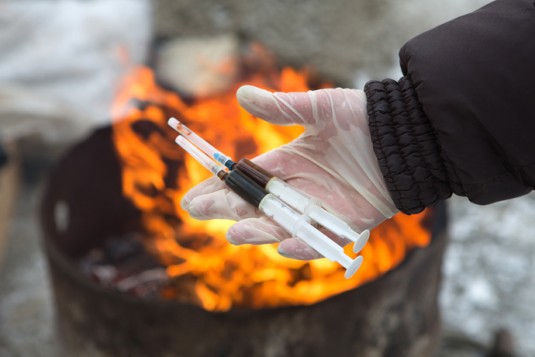A flesh eating disease has made its way from Russia to the U.S– and in a matter of a week it made its way from the west to the Midwest, more specifically Joliet. The flesh eating disease has surfaced in drug users. People think they are buying heroine on the streetsand they are getting something called ‘krokodil‘ instead. It is the Russian word for ‘crocodile’– named so because it first creates a green scaly wound on your skin before it begins to spread and eat away at your flesh, muscles, even tendons.

Dr. Abhin Singla is an addiction specialist with presence St. Joseph Medical Center in Joliet. He has been reading about the effects of krokodil for 10 years. Last week it surfaced in Arizona and Utah. Sunday it walked into his hospital in the southwest suburbs. “All I smelled was rotten flesh. I knew exactly what that was,” Dr. Singla said.
Two women in their 20′s thought they were buying heroine and got krokodil instead. Within minutes of administering the injection, their symptoms resembled those of krokodil users, but the damage now is far more extensive. Krokodil is made of gasoline, paint thinner, butane and other harmful chemicals. And it’s made its way to Joliet of all places because, the doctor thinks– so many interstates pass by or go through Joliet.
According to Dr. Singla, krokodil hit near-epidemic proportions in Russia between 2000 and 2002. It is one third the cost of heroin and three times as potent. But the high doesn’t last as long. Overdose is common. In the end, if the addiction doesn’t kill the user, history shows the flesh eating disease typically does.
Copyright WGN News
________________________________________________________
Krokodil, the skin-eating drug, may have claimed its first U.S. victim. The heroin-like drug, which originated in Russia began cropping up in the U.S. last month and has been found in Utah, Arizona and Illinois recently. The Oklahoma Bureau of Narcotics is investigating the deaths of two Oklahoma men who are linked to the drug, KSOW reported. One of those men is 33-year-old Justin McGree, who died last year. McGee’s friend Chelle Fancher said McGee had taken Krokodil. “(His) skin was missing,” she told KOCO Oklahoma City. “The doctors say it ate him from the inside out. It wasn’t until the next day that they told us that is was Krokodil meth.” The drug is an opiate, but like meth is made from crude materials that are readily available, such as gasoline. If the deaths are connected to Krokodil, the drug may have been in the U.S. earlier than authorities have suspected.
From TIME.com

















